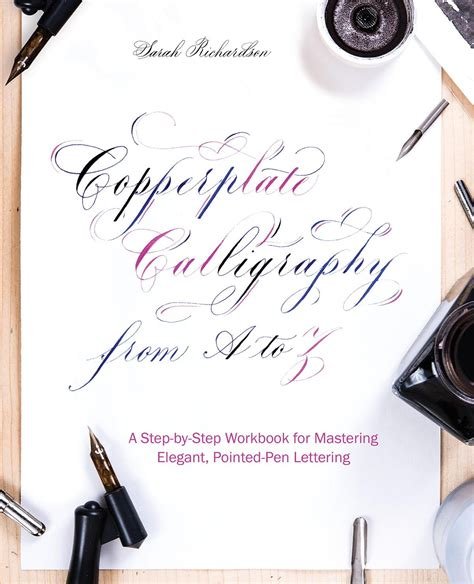The Art of Calligraphy: Mastering the Elegance of Handwritten Letters
Calligraphy, the art of creating beautiful, elegant, and expressive handwritten letters, has a long and rich history. From its origins in ancient civilizations to its modern-day resurgence as a popular hobby and artistic practice, calligraphy has captivated people with its timeless appeal. In this blog post, we will delve into the world of calligraphy and explore its various aspects, from different styles and essential tools to mastering techniques and adding decorative elements. Whether you are a beginner looking to learn the basics or an experienced calligrapher seeking to enhance your skills, this post will provide valuable insights and tips to help you on your calligraphy journey. So, grab your pens, brushes, and ink, and let’s embark on a mesmerizing exploration of the art of calligraphy.
Introduction to Calligraphy: A Beautiful Art Form
Calligraphy is a timeless and beautiful art form that has been practiced for centuries. It is the visual art of writing, using decorative lettering and flourishes to create aesthetically pleasing designs. Calligraphy is often used for formal invitations, event signage, and artistic expression.
One of the key elements of calligraphy is the use of different writing tools, such as pens and brushes, to create unique and visually appealing letterforms. This art form requires patience, attention to detail, and a steady hand to create the intricate designs and elegant script.
Calligraphy has a rich history and is deeply rooted in various cultures around the world. From ancient civilizations to modern times, calligraphy has been used to express religious texts, important documents, and artistic creations. The art of calligraphy has evolved over time, with different styles and techniques emerging from different regions and time periods.
Whether you are a seasoned calligrapher or a beginner, the art of calligraphy offers a rewarding and enriching creative outlet. It is a way to express oneself through the beauty of written language and create visually stunning pieces of art.
Understanding the History and Origins of Calligraphy
Calligraphy is a beautiful art form with a rich history that dates back to ancient civilizations. The word ‘calligraphy’ is derived from the Greek words ‘kallos’ meaning beauty, and ‘graphein’ meaning to write. This form of expressive writing has been practiced for centuries in various cultures around the world, each with its own unique style and techniques.
The origins of calligraphy can be traced back to ancient China, where it was used for religious texts and official documents. It then spread to other parts of Asia, such as Japan and Korea, where it developed its own distinct styles. In the Islamic world, calligraphy became a highly revered art form, with intricate designs and patterns adorning manuscripts and architecture.
During the Middle Ages in Europe, calligraphy was predominantly practiced by monks who meticulously copied religious texts and manuscripts by hand. It was during this time that different writing styles such as Gothic and Italic calligraphy emerged, each with its own set of rules and guidelines.
Understanding the history and origins of calligraphy provides insight into its cultural significance and the influence it has had on art, design, and communication throughout the ages. Exploring the evolution of calligraphy from ancient civilizations to modern times allows us to appreciate the diversity and beauty of this timeless art form.
Different Calligraphy Styles: Exploring the Variety of Handwriting
Calligraphy is a beautiful art form that comes in a variety of styles, each with its own unique characteristics and history. As you delve into the world of calligraphy, you’ll discover the rich diversity of handwriting styles that have evolved over centuries, each with its own cultural and historical significance.
From the elegant and flowing lines of Copperplate to the bold and expressive strokes of Gothic, the world of calligraphy offers a wide range of styles to explore and master. While some styles may appear more traditional and formal, others may be more modern and casual, catering to different preferences and artistic expressions.
Understanding the different calligraphy styles allows you to appreciate the beauty and complexity of this art form, as well as to find the style that resonates with you the most. Whether you’re drawn to the classic elegance of traditional scripts or the contemporary flair of modern styles, there’s a calligraphy style out there for everyone.
Exploring and experimenting with different calligraphy styles can help you develop a deeper understanding of the art form, as well as expand your creative horizons. By trying out new styles and techniques, you can broaden your skillset and develop a unique and personal approach to calligraphy that reflects your individual taste and artistic vision.
Essential Tools for Calligraphy: Pens, Brushes, and Ink
When it comes to calligraphy, having the right tools is crucial to creating beautiful and precise lettering. The most essential tools for calligraphy are pens, brushes, and ink. Each of these tools plays a unique role in the art of calligraphy and choosing the right ones can greatly impact the quality of your work.
First and foremost, pens are the primary tool used in calligraphy. They come in a variety of sizes and nib styles, each creating a different effect on the page. The type of pen you choose will depend on the style of calligraphy you wish to pursue. For example, broad-edge pens are ideal for creating bold, Roman style lettering, while pointed pens are better suited for creating delicate, flowing script.
Next, brushes are another essential tool for calligraphy, particularly for more expressive and artistic styles. Brush calligraphy allows for variation in line width and can create beautifully fluid and dynamic lettering. Brushes come in a range of sizes and materials, and choosing the right brush is important for achieving the desired effect in your calligraphy work.
Finally, ink is a critical element in calligraphy, as the type of ink you use can greatly impact the final result. Different inks have different properties, such as viscosity, drying time, and color intensity. It’s important to experiment with different types of ink to find the one that best suits your style and technique.
Mastering the Basic Calligraphy Techniques: Strokes and Lines
When it comes to calligraphy, mastering the basic techniques of strokes and lines is essential for creating beautiful lettering. The foundation of calligraphy lies in the ability to control the thickness and thinness of your lines, as well as the direction and flow of your strokes. Whether you are using a traditional dip pen or a modern brush pen, understanding the fundamental techniques is key to creating elegant and expressive calligraphy.
One of the first things to master in calligraphy is achieving consistent and even strokes. This involves practicing the pressure you apply to the pen or brush as you move it across the page. By varying the pressure, you can create lines with varying thickness, adding depth and character to your lettering. Learning how to control the flow of ink or paint will also contribute to the overall quality of your strokes and lines.
Another important aspect of mastering calligraphy techniques is understanding the proper angles and positions for creating different types of lines. The way you hold the pen or brush, as well as the angle at which you make your strokes, can greatly impact the overall look and feel of your lettering. By practicing different strokes and lines, you can become more comfortable with the various movements and angles required for different calligraphy styles.
Overall, mastering the basic calligraphy techniques of strokes and lines takes time and practice. It is important to be patient and persistent in honing your skills, as the ability to create smooth, flowing lines and precise, elegant strokes is essential for producing stunning calligraphy artwork and lettering.
The Importance of Typography in Calligraphy: Choosing the Right Fonts
Typography plays a crucial role in the art of calligraphy, as the choice of fonts can greatly impact the overall look and feel of a piece. Different fonts can convey different emotions and aesthetics, making it important to carefully consider which one to use for your calligraphy project.
When choosing a font for calligraphy, it’s essential to consider the historical context and the intended message of the piece. For example, using a classic and elegant font like Copperplate might be suitable for formal invitations or certificates, while a more modern and funky font like Brush Script could add a playful touch to a casual greeting card.
Another important factor to consider when selecting a font is readability. Some decorative fonts may look beautiful, but if they are difficult to read, they might not be the best choice for conveying a clear message. It’s crucial to prioritize legibility to ensure that your calligraphy piece effectively communicates its intended text.
Ultimately, the importance of typography in calligraphy lies in its ability to enhance the aesthetic and emotional impact of the written word. By carefully choosing the right font, calligraphers can elevate their work and create truly captivating pieces of art.
Creating Harmony in Calligraphy: Balancing Spacing and Proportions
When it comes to calligraphy, creating harmony in your work is essential. One of the key elements in achieving this harmony is balancing spacing and proportions. The way in which the letters and words are spaced on the page can greatly impact the overall visual appeal of the piece.
Proper spacing is crucial for readability and aesthetic appeal. As you practice calligraphy, pay attention to the balance between the individual letters, the words, and the lines of text. The spacing should be consistent throughout the piece, and the proportions of the letters should be harmonious.
Using guidelines can be incredibly helpful in ensuring that your calligraphy maintains balanced spacing and proportions. Guidelines provide a framework for your writing and can help you keep the size and spacing of your letters consistent. They can also assist you in achieving a balanced layout for your calligraphy piece.
Additionally, being mindful of the proportions of the individual letters and the overall composition is important for creating harmony in calligraphy. Each letter should be well-proportioned and flow seamlessly with the rest of the text. The overall layout and structure of the piece should feel balanced and visually pleasing.
Adding Flourishes and Decorations: Enhancing the Beauty of Letters
When it comes to calligraphy, adding flourishes and decorations can take your writing to another level. Whether you’re creating decorative letters for a project or simply practicing your skills, embellishing your lettering can add a touch of elegance and personality to your work.
There are countless ways to enhance the beauty of letters with flourishes and decorations. From simple vines and swirls to more intricate designs, you can experiment with different styles and techniques to find what best suits your personal taste and the project at hand.
Remember, the key to successfully adding flourishes and decorations is to maintain a sense of balance and harmony. While it can be tempting to go overboard with embellishments, it’s important to ensure that your decorative elements complement the overall look of your calligraphy rather than overwhelm it.
Ultimately, mastering the art of adding flourishes and decorations to your calligraphy takes practice and patience. By experimenting with different styles and paying attention to the spacing and proportion of your embellishments, you can create stunning, visually appealing letters that are sure to impress.
Using Colors in Calligraphy: Techniques for Vibrant and Expressive Writing
When it comes to calligraphy, incorporating colors can add a whole new dimension to your writing. Colors can convey different emotions and enhance the overall aesthetic of your work. There are various techniques for using colors in calligraphy that can help you create vibrant and expressive pieces.
One technique is to use watercolor to paint over your calligraphy. This can create a beautiful, gradient effect that adds depth and character to your writing. Another way to incorporate colors is to use colored inks with different brush sizes to create variations in line thickness and color intensity.
It’s also important to consider the color scheme you want to use for your calligraphy piece. Choosing complementary colors can create harmony and balance in your work, while using contrasting colors can add a dynamic and eye-catching element. Experimenting with different color combinations can help you discover what works best for your style.
Ultimately, the use of colors in calligraphy is a powerful tool for self-expression and creativity. By mastering various color techniques and experimenting with different color palettes, you can elevate your calligraphy to new levels of vibrancy and expressiveness.
Practicing Calligraphy: Tips for Improving Your Handwriting Skills
title: Introduction to Calligraphy: A Beautiful Art Form
content:
When it comes to calligraphy, practice makes perfect. Whether you are a beginner or a seasoned calligrapher, there are always ways to improve your handwriting skills. One of the most important tips for practicing calligraphy is to start with the basics. Focus on mastering the fundamental strokes and lines of calligraphy before moving on to more complex styles.
Another essential tip for improving your calligraphy skills is to practice consistently. Set aside dedicated time each day to work on your handwriting, and don’t be afraid to experiment with different techniques and styles. It’s also helpful to seek inspiration from other calligraphers and artists, as well as to study the work of historical masters of the craft. By examining different styles and techniques, you can expand your own artistic repertoire.
It’s also important to be patient with yourself as you practice calligraphy. Rome wasn’t built in a day, and neither were the great works of calligraphy. Take your time and don’t be discouraged by mistakes. Every stroke and line you make is an opportunity to learn and grow as a calligrapher. Even the most experienced artists are always learning and improving their skills.
Lastly, don’t forget to have fun with calligraphy! It’s a beautiful and expressive art form, and the process of practicing calligraphy can be just as rewarding as the final product. Don’t be afraid to let your creativity shine through in your work, and enjoy the journey of honing your calligraphy skills.
Frequently Asked Questions
What is calligraphy?
Calligraphy is the art of beautiful and elegant handwriting, often used for formal purposes such as invitations and certificates.
What are the essential tools for calligraphy?
The essential tools for calligraphy include pens, brushes, and ink, each of which can create unique and beautiful writing styles.
How can I improve my calligraphy skills?
Practicing calligraphy regularly, experimenting with different styles and techniques, and seeking feedback from experienced calligraphers can help improve your skills.
Why is typography important in calligraphy?
Typography plays a crucial role in calligraphy as it determines the style and design of the letters, contributing to the overall aesthetic appeal of the writing.
What are some common calligraphy styles?
Some common calligraphy styles include italic, copperplate, uncial, and brush lettering, each with its own unique characteristics and history.
How can I create harmony in my calligraphy?
Creating harmony in calligraphy involves balancing spacing and proportions, as well as adding flourishes and decorations to enhance the overall beauty of the letters.
What role do colors play in calligraphy?
Colors can be used in calligraphy to add vibrancy and expressiveness to the writing, as well as to create visual interest and highlight certain aspects of the text.






